If you’ve never thought about making homemade sauerkraut, this recipe will show you how ridiculously easy it is to make your own in just a few days.
With only 2 simple ingredients you'll never go back to grocery store-bought kraut again. Plain cabbage never tasted so good!
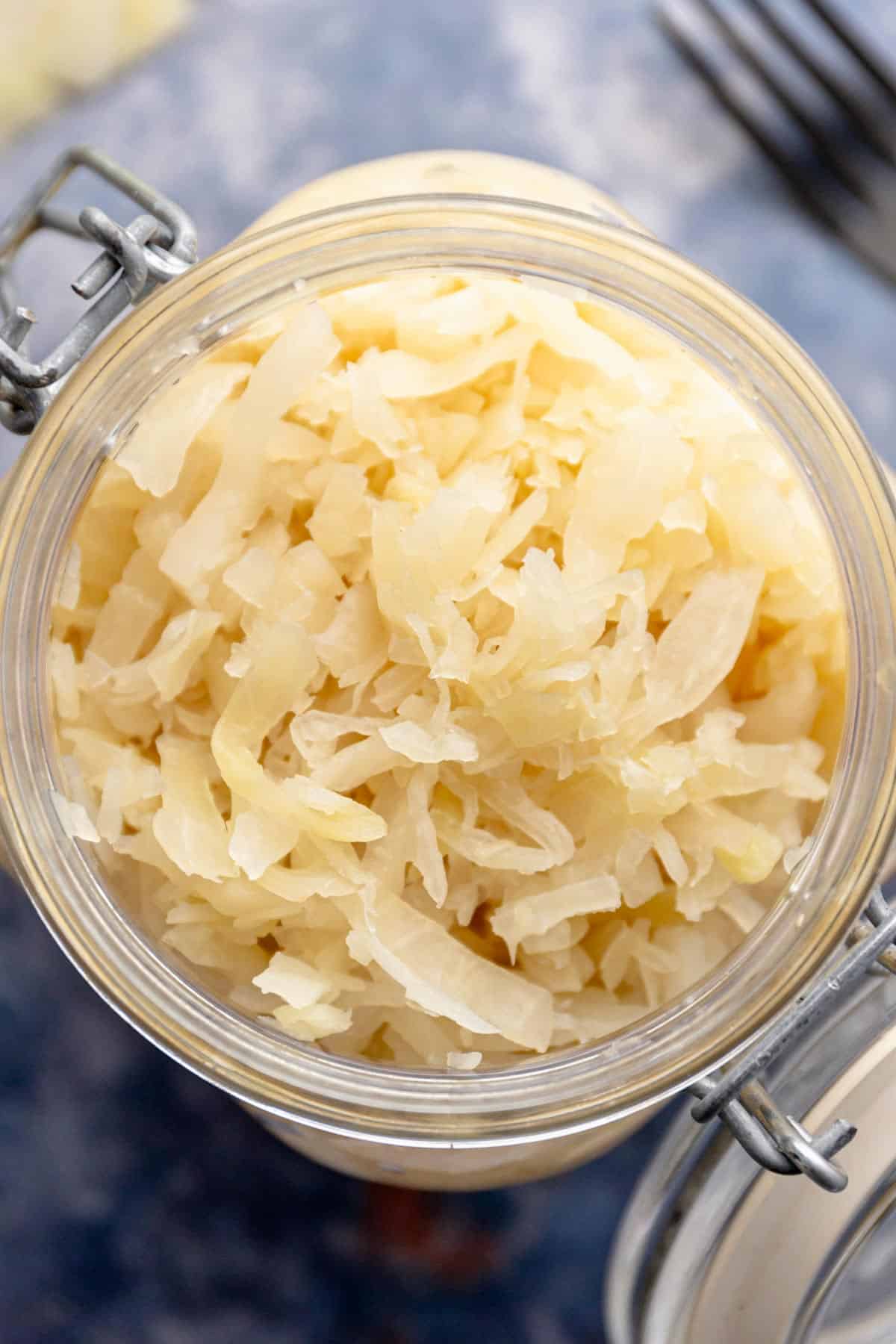
Homemade Sauerkraut
Making homemade sauerkraut is easier than you think, and this recipe has been passed down in my family for years.
With just a few simple ingredients and a little patience, you’ll have crunchy, tangy sauerkraut that tastes just like home.
I’ll share my cooking tips for fermenting and storing so it turns out perfectly every time, even if it’s your first try!
Cabbage is my favorite ingredient, and I love cooking with it every week. Don't miss my collection of the best cabbage recipes including pickled cabbage and kielbasa with sauekraut. SO yummy!
Want to Save This Recipe?
Enter your email and we’ll send the recipe directly to you!
By submitting this form, you consent to receive emails from The Yummy Bowl.
Why This Homemade Sauerkraut Is Yummy
- Tart. The pound of cabbage is transformed into tart fermented sauerkraut that complements the flavors of many dishes well.
- Versatile. You can easily add some spice, seasonings, or other vegetables to change the flavor of the sauerkraut.
- Easy. With just a few minutes of massaging the cabbage and a few days of fermentation, you end up with a tasty, flavorful condiment to add to your meals.
- Compatible. Sauerkraut easily pairs with several dishes and ingredients. You can easily use it in fried cabbage recipe, saute kraut with sausage, or enjoy it with beef.
Ingredients
- Green cabbage - look for a firm head of cabbage to make the sauerkraut.
- Sea salt - use sea salt to help bring out the natural juices of the cabbage. Canning salt is also an option, but not essential if you have sea salt.
- For brine if needed - 1 additional tablespoon of salt and 4 cups water.
📋 You can find the full ingredient list in the Recipe Card below the article.
How To Make Sauerkraut
- Prep the cabbage. Begin by rinsing the cabbage and discarding any wilted outer leaves of the cabbage.


Quarter the cabbage by using a sharp knife.
Remove the core and then slice the cabbage into thin strips, aiming for approximately ¼ inch in width. The strips don't have to be perfectly uniform. If you prefer you can also use shredded cabbage.
Transfer the sliced cabbage into a large bowl and evenly sprinkle sea salt.
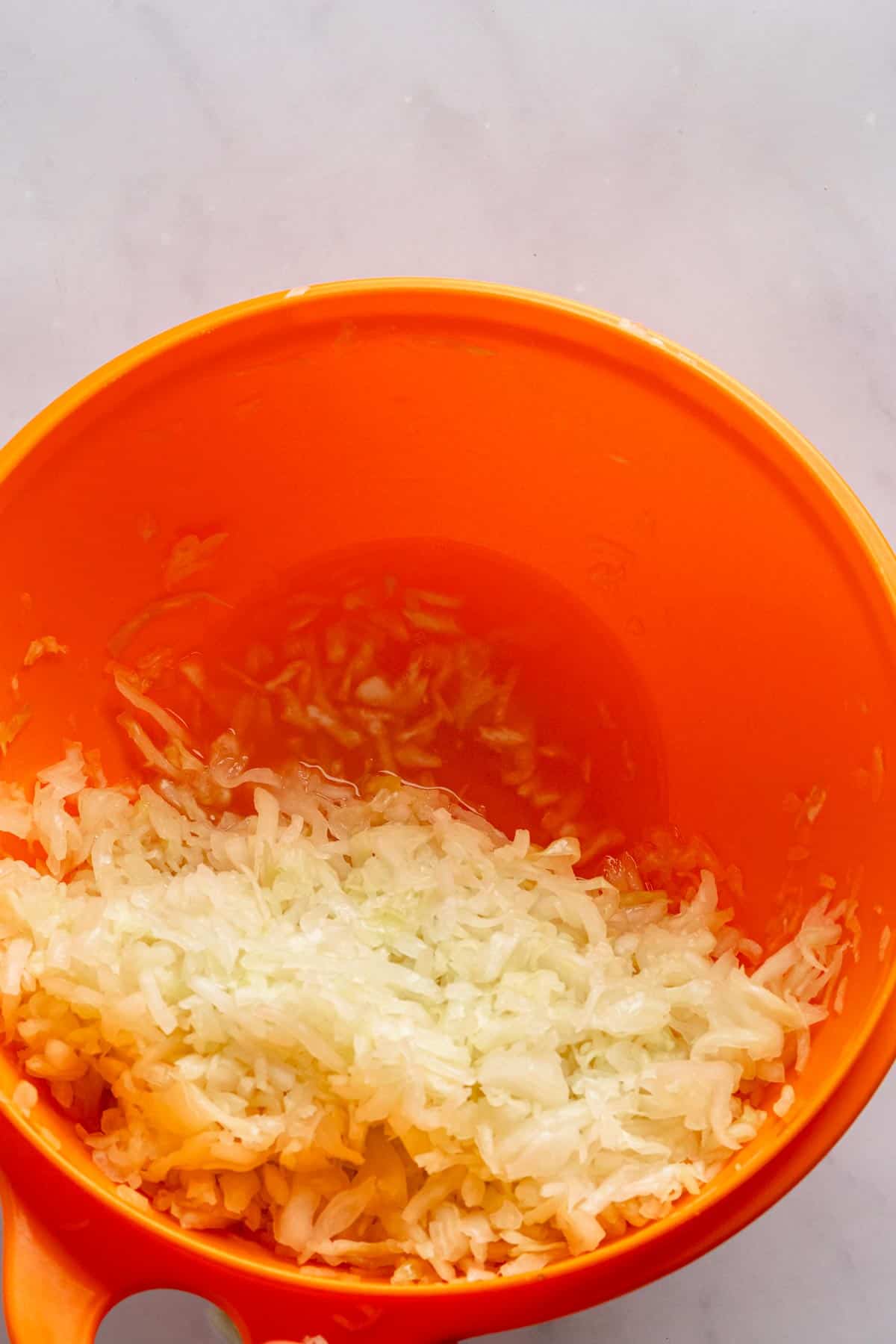
- Mash the cabbage. Now, initiate the mashing process. There's no specific technique; the best way is to use clean hands and massage the cabbage. The objective is to kickstart the release of juices from the cabbage.
Continue mashing or kneading for about 5-8 minutes. By the end, you should have a pool of salty cabbage juice in your bowl as the salt draws juices from the cabbage.
- Canning. Take a few handfuls of the mashed cabbage and place them in a glass jar, then compress them thoroughly using a wooden spoon. The goal is to remove as many air bubbles as possible.
Repeat this process of packing and mashing in small batches until the jar is nearly full, but leave approximately 1-2-inch headspace at the top.
If the cabbage is not fully submerged in its liquid, prepare a 2% brine solution to fill the remaining space. (Failing to cover the cabbage fully may lead to mold and other issues.)
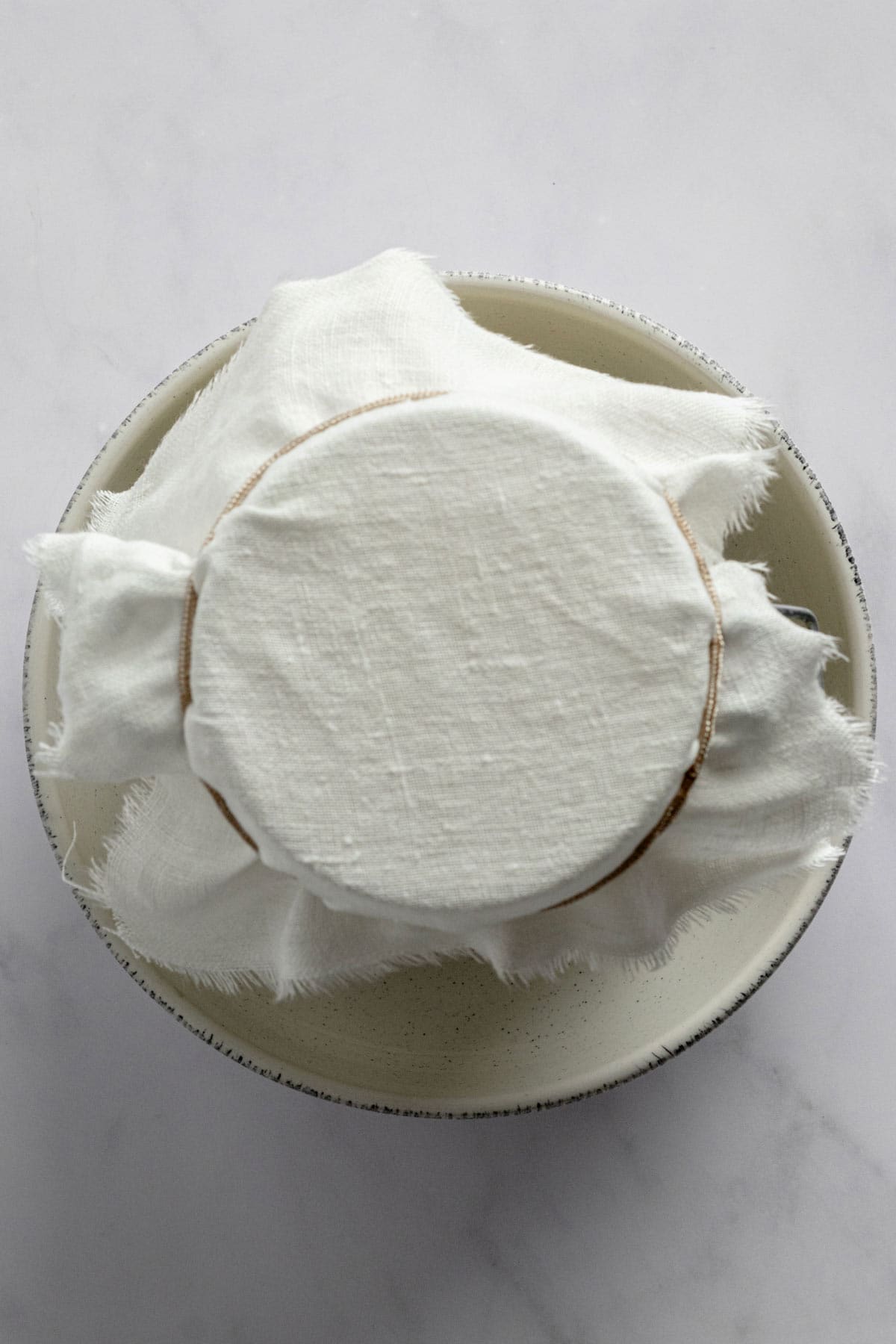
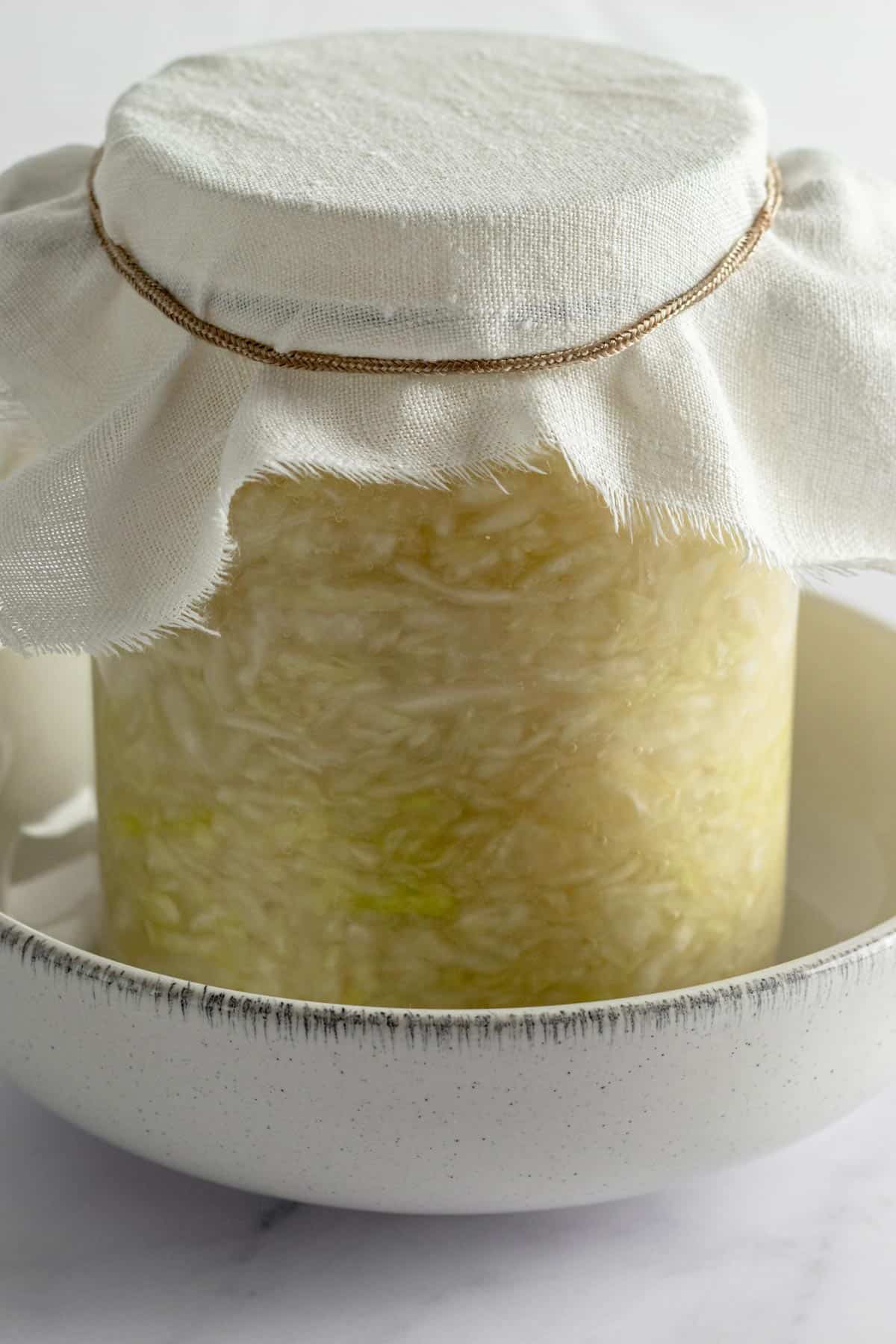
- To make a 2% brine: Dissolve 1 tablespoon of fine sea salt in 4 cups of non-chlorinated water. Any unused brine can be stored in a container or a bag. Store the brine-filled container in the fridge.
Cover cabbage with the brine, leaving a 2-inch headspace from the top. If the cabbage keeps floating to the surface, you can use a glass weight to hold it down or wedge a piece of the cabbage core on top.
Seal the jar tightly using a linen cloth or a similar cover and secure it with a rubber band.
How long to ferment sauerkraut. Place the jar in a dark space at room temperature. Keep away from direct sunlight for at least one week.
To prevent potential spills, consider putting a small dish or tray under the jar, as jars tend to leak. Additionally, it's a good idea to open the lid after a day or so to release any trapped gases.
After one week, taste and smell your sauerkraut. If it's tangy enough to your liking, transfer it to the refrigerator for storage. If you desire a stronger tang, let it ferment a bit longer.
Enjoy it as a side dish, use it in stir fries or make a hearty polish sauerkraut soup.
- Further reading: How to ferment vegetables, Benefits of fermented vegetables.
📋 Sauerkraut taste: The sauerkraut will be moist, tangy and crunchy.
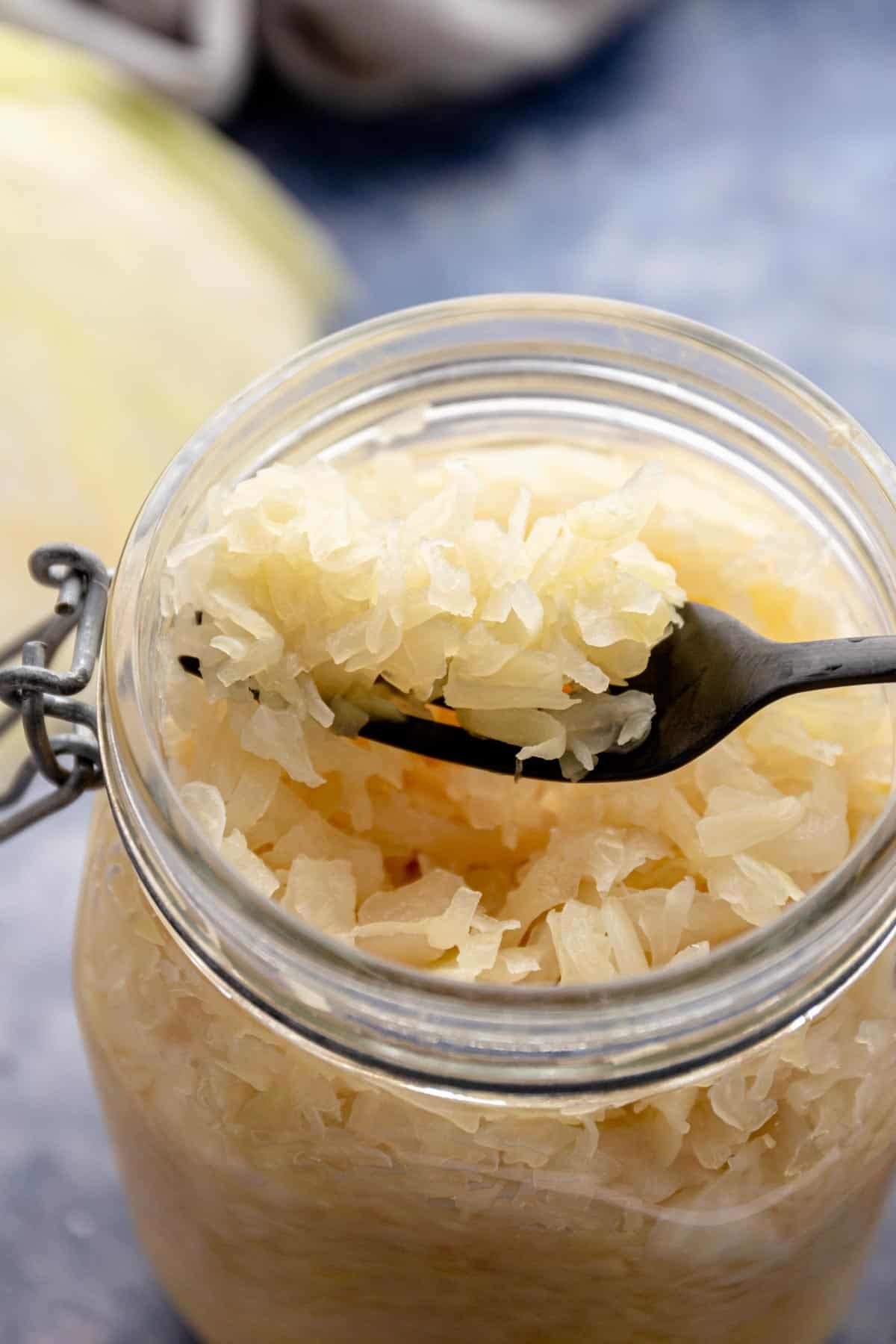
Tips
- Check the cabbage daily to ensure it has enough liquid to ferment in so it can create good bacteria and produce good sauerkraut.
- Taste after 5 days. If the cabbage tastes to your liking, transfer it to the refrigerator for 3-6 months. If not, allow it to ferment for another 2 days and then taste again. The longer the cabbage is fermenting, the sharper the flavor. There's no fixed minimum or maximum fermentation time; it's safe to eat throughout the process.
- You may end up with some exposed sauerkraut at the top of the jar that looks like it went off. Throw it away, but if the rest of the jar looks okay, it’s fine to eat it.
- If you have leftover cabbage, read this post about how to store cabbage.
- From my experience as a food professional, the best cabbage varieties for making sauerkraut is green cabbage. Red is also an option, but not as yummy and with a soft texture like green.
- Further reading: What to eat with cabbage steaks.
Recipe Troubleshoot
- Bubbles, white scum & foam. You may see those on the surface of the sauerkraut, but these are all typical signs of fermentation. Gently remove them before eating.
- Brine may bubble over if fermentation is very active or the jar is too full. Use a larger jar to prevent this. If it does happen, place a plate under the jar to catch any overflow and ensure the cabbage stays submerged.
- Too salty? Rinse sauerkraut briefly under running water to reduce saltiness, but use this sparingly to preserve beneficial bacteria—or dilute sauerkraut by adding water to lessen the saltiness.
- Too sour? You can balance sauerkraut's sourness by adding a touch of sweetness. This can be done with a bit of sugar or honey or by mixing in sliced apples or pears for a natural, sweet touch.
How to Season Sauerkraut
I like to leave the sauerkraut plain as it is but feel free to add some classic seasonings:
- Stir in caraway seeds or celery seeds.
- Mix in grated beets (try this pickled cabbage) or carrots.
- Try mix-ins like raisins and apples.
- Add thin slices of fennel or celery root.
- Include ground turmeric or ginger.
Serving Suggestions
If you aren’t quite sure how to eat your homemade sauerkraut, here are some suggestions. The beauty of this side dish is that you can eat it hot or cold!
- On top of a hot dog or sausage or a burger like this salmon burger or cheddar burger.
- Make a sauerkraut soup
- In a sandwich: crispy chicken ciabatta sandwich.
- Use it as a filling for pierogi.
- Stir into omelet or frittata.
- Make a stir fry with bacon, sausage or with noodles.

Freezing And Storing Instructions
- To Store. If you are wondering how long sauerkraut is good for, I can tell you it lasts for months! You can store sauerkraut in the fridge for up to 4 months. Store in the mason jar or in a plastic container.
- Freezing is not the best alternative to experience the health benefits of sauerkraut as it may kill off the beneficial bacteria that have developed during the fermentation process.
- Related: 7 Easy Sauerkraut Substitutes
Did You Like This Recipe?
Leave a ⭐️⭐️⭐️⭐️⭐️ rating below and share it on Instagram, Facebook, and Pinterest!
Recipe Card
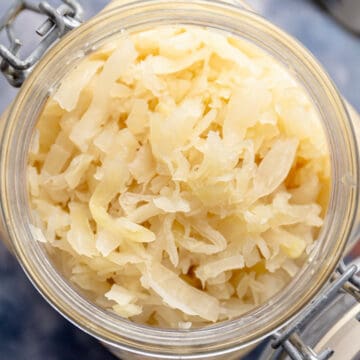
How To Make Easy Canned Sauerkraut
VIDEO
Want to Save This Recipe?
Enter your email and we’ll send the recipe directly to you!
By submitting this form, you consent to receive emails from The Yummy Bowl.
INGREDIENTS
- 3 pounds green cabbage
- 1 tablespoon sea salt
- clean glass jar, I used 1 32 ounce jar, about 1 litre
For brine if needed:
- 1 additional tablespoon of salt and 4 cups water
INSTRUCTIONS
- Prep the cabbage. Begin by rinsing the cabbage and discarding any wilted outer leaves of the cabbage.
- Quarter the cabbage by using a sharp knife. Remove the core and then slice the cabbage into thin strips, aiming for approximately ¼ inch in width. It's not essential for the strips to be perfectly uniform. If you prefer you can also use shredded cabbage.
- Transfer the sliced cabbage into a large bowl and evenly sprinkle sea salt over it.
- Mash the cabbage. Now, initiate the mashing process. There's no specific technique; the best way is to just use clean hands and massage the cabbage. The objective is to kickstart the release of juices from the cabbage.
- Continue mashing or kneading for about 5-8 minutes. By the end, you should have a pool of salty cabbage juice in the bottom of your bowl as the salt draws juices from the cabbage.
- Canning. Take a few handfuls of the mashed cabbage and place them in a glass jar, then compress them thoroughly using a wooden spoon. The goal is to remove as many air bubbles as possible.
- Repeat this process of packing and mashing in small batches until the jar is nearly full, but leave approximately 1-2-inch headspace at the top.
- If the cabbage is not fully submerged in its own liquid, prepare a 2% brine solution to fill the remaining space. (Failing to fully cover the cabbage may lead to mold and other issues.)
- To make a 2% brine: Dissolve 1 tablespoon of fine sea salt in 4 cups of non-chlorinated water. Any unused brine can be stored in a container or a bag. Store the brine-filled container in the fridge.
- Cover cabbage with the brine, leaving a 2-inch headspace from the top. If the cabbage keeps floating to the surface, you can use a glass weight to hold it down or wedge a piece of the cabbage core on top.
- Seal the jar tightly using a linen cloth or a similar cover and secure it with a rubber band.
- How long to ferment sauerkraut. Place the jar in a dark space at room temperature. Keep away from direct sunlight for at least one week.
- To prevent any potential spills, consider putting a small dish or tray under the jar, as the jars have a tendency to leak. Additionally, it's a good idea to open the lid after a day or so to release any trapped gases.
- After one week, taste and smell your sauerkraut. If it's tangy enough to your liking, transfer it to the refrigerator for storage. If you desire a stronger tang, allow it to ferment a bit longer.
- Enjoy it as a side dish, use it in stir fries or make a hearty polish sauerkraut soup.
NOTES
- Sauerkraut taste: The sauerkraut will be moist, tangy and crunchy. Check the cabbage daily to ensure it has enough liquid to ferment in so it can create good bacteria and produce good sauerkraut. Taste after 5 days. If cabbage tastes to your liking, then transfer it to the refrigerator for 3-6 months. If not, then allow it to ferment for another 2 days and then taste again. The longer cabbage is fermenting the sharper the flavor. There's no fixed minimum or maximum fermentation time; it's safe to eat throughout the process.
- To Store. It lasts for months! You can store sauerkraut in the fridge for up to 4 months. Store in the mason jar or in a plastic container.
ADD YOUR OWN PRIVATE NOTES
NUTRITION
FAQs
In this recipe, I am using a 3-pound cabbage and using one tablespoon of salt.
The amount of salt you use depends on how many pounds of cabbage you have. If you have a smaller cabbage, you can use less, or if you have a bigger cabbage, you may need more.
The sauerkraut fermentation happens as the cabbage is mixed with salt, which draws out the moisture from the cabbage heads to create a brine. The cabbage sits and ferments in this brine.
No, cole slaw is a salad made with shredded coleslaw, while sauerkraut is made with heads of cabbage that soak in a saltwater brine and ferment.
Yes, this recipe is 100% gluten free.
Recipe adapted from The Prairie Homestead






Rich
The only thing I don't add is the water.
For an average cabbage I add a harping tablespoon of salt to cabbage that has been sliced. Cover with towel for a few hours, or overnight.
Squeeze and pack in jars. Within 24 hours, the salt has extracted enough water..
If you don't have anything to hold the cabbage under the brine. Tetris ziplock bag with salt water in it.
Julia | The Yummy Bowl
That is a great tip! Thank you for sharing Rich!
Julia | The Yummy Bowl
Canning sauerkraut is easier than you think, just 20 minutes to make, ferment for a couple of days and you can enjoy a delicious side dish for months.